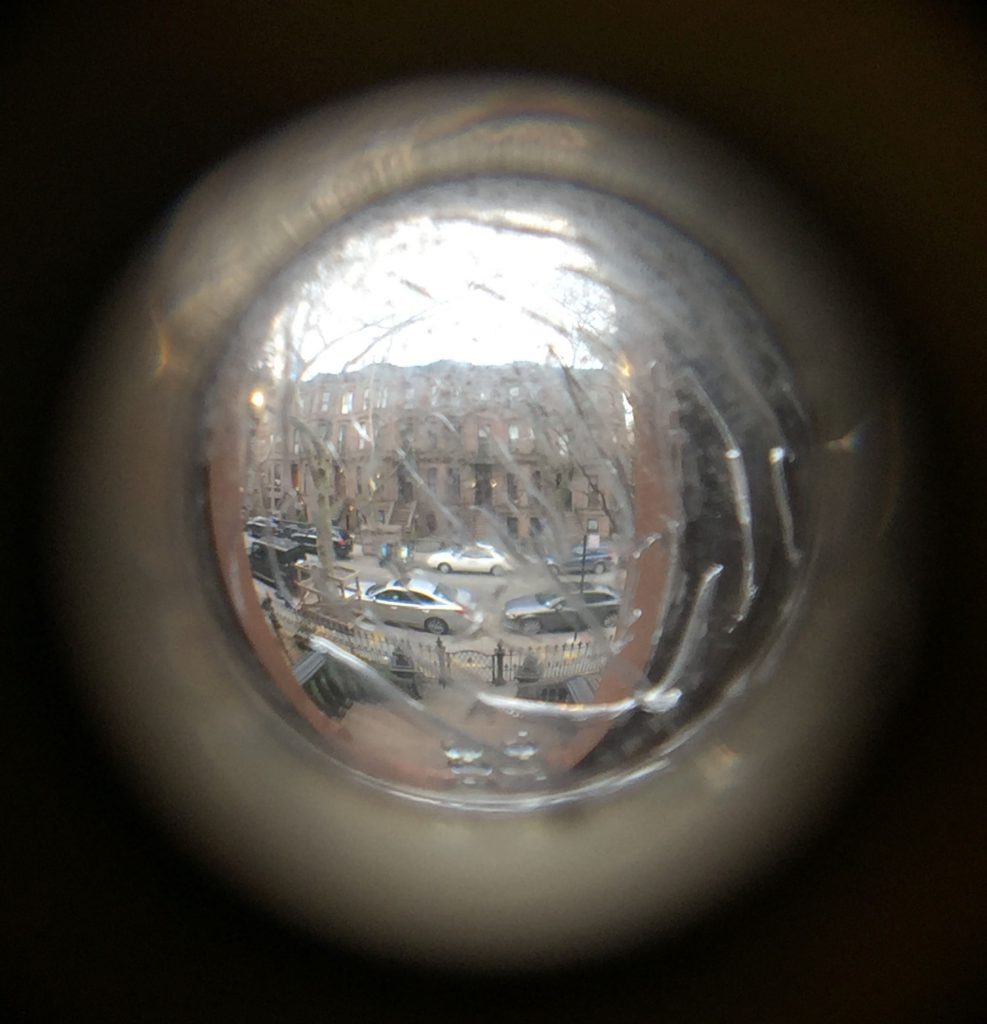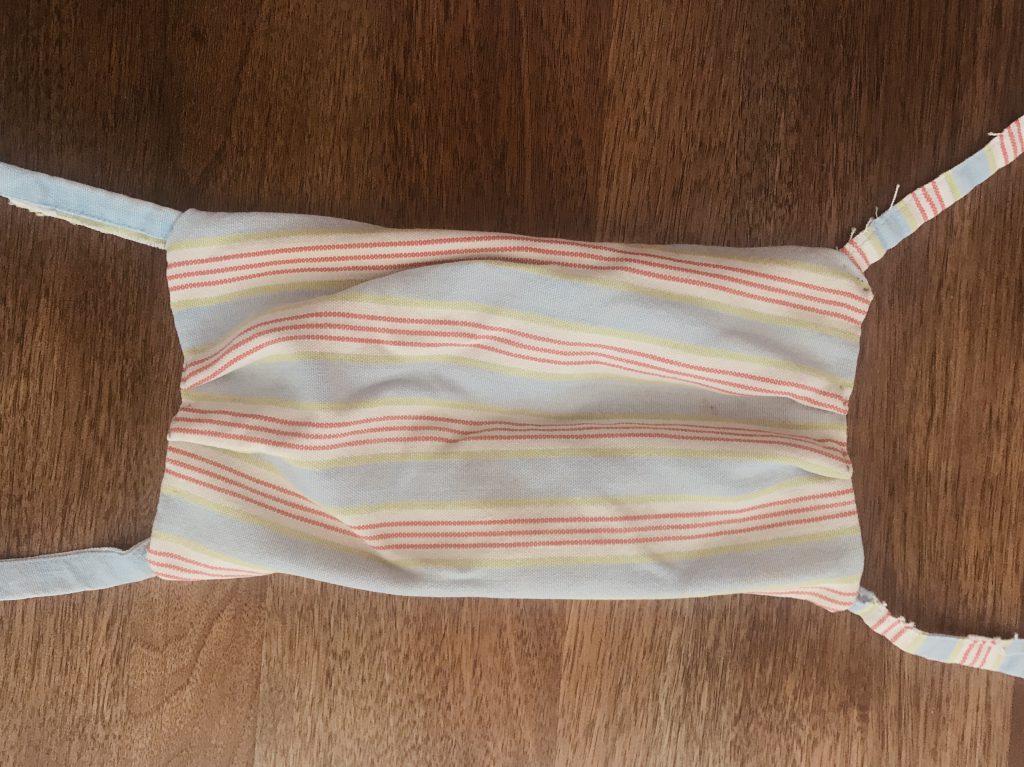When German conceptual artist Joseph Beuys came to the United States for the first time in 1974 he conceived of his own version of quarantine. Angered by the US involvement in the Vietnam War, Beuys arrived in NYC and refused to set his feet down on American soil. Blindfolded, he saw nothing other than a coyote that was inside the gallery with him the entire time. As if he were thinking about the situation immigrants still face in detention centers in 2020, he named his piece ‘I Like America and America Likes Me’, with full ironic bite. Now during this time of Corona Virus shelter, we can revisit Beuys’ prescient work, finding ourselves in isolation, and wanting to express our own anger at the country where we would normally be living. We are INQUILINES, temporary inhabitants of a shelter that may or may not protect us.
Places
RETE: Mix things up
In case of flesh wound, blood will clot.
Fibrin (a thread-like protein) forms network. It dries up.
Clot becomes scab. Scab protects. Healing begins.
Dear earth, may it be so. May we let it happen. Dear you… Drink water. Mix up your life. Eat your veggies. Hug a tree. Call one another. Near and far. Someone new. Skype and zoom. Travel. Across time zones.
Ask “What’s up?”… Stay home.
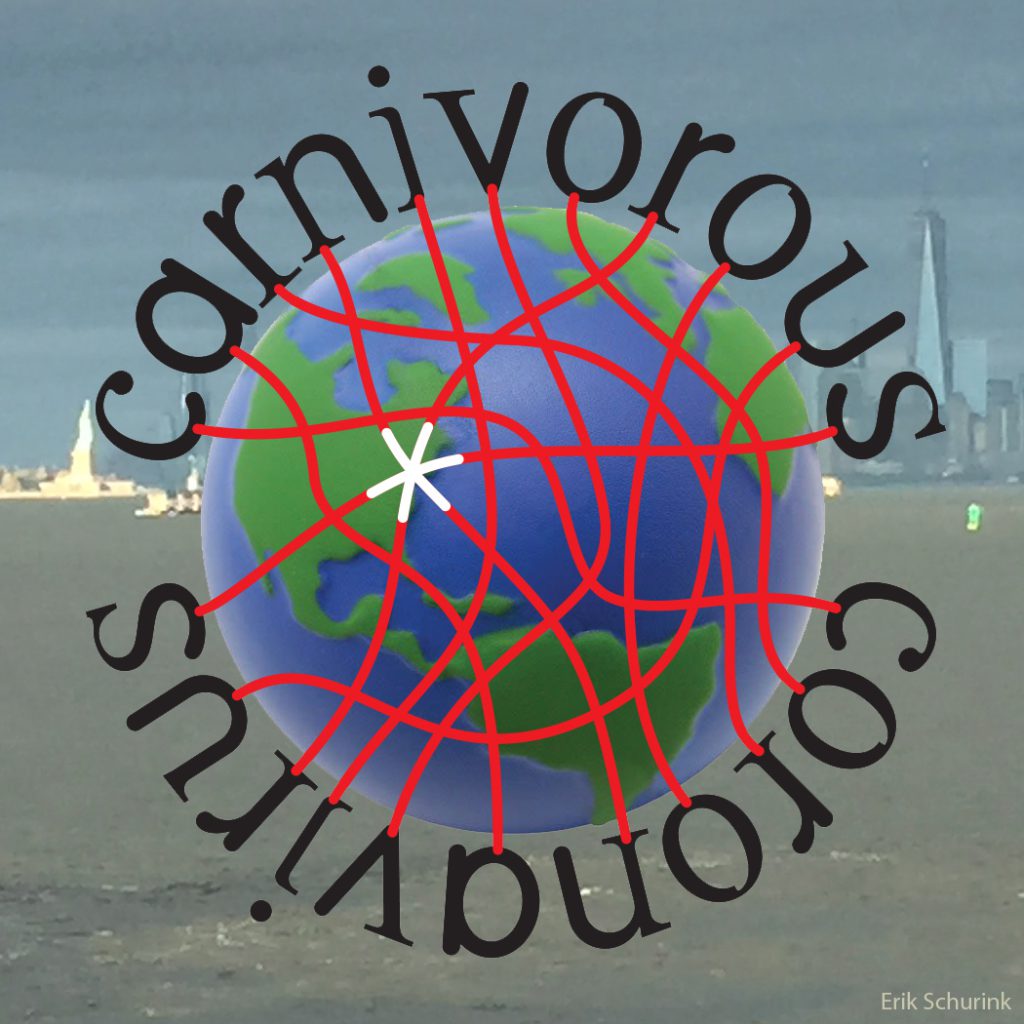
the quiver of bone and the rings of a tree trunk
I don’t remember much from high school biology. What I can recall is that a bone’s capillary network is arranged in a series of concentric circles. This means that at the microscopic level, our insides resemble the rings of a tree trunk. This shared architecture has been running my mind. The trees on my block are just beginning to flower; the budding branches are tender and bright. As for myself, after weeks of eating chips and festering in my apartment, I am growing sour and more bloated by the day. How dare you! I think, glumly staring at the view from my window. Nobody is flourishing right now, but spring is a reminder some things are certain. The sun rises, flowers bloom. With each passing year a tree gains a new ring around its trunk and grows stronger, all the more able to weather what comes next.
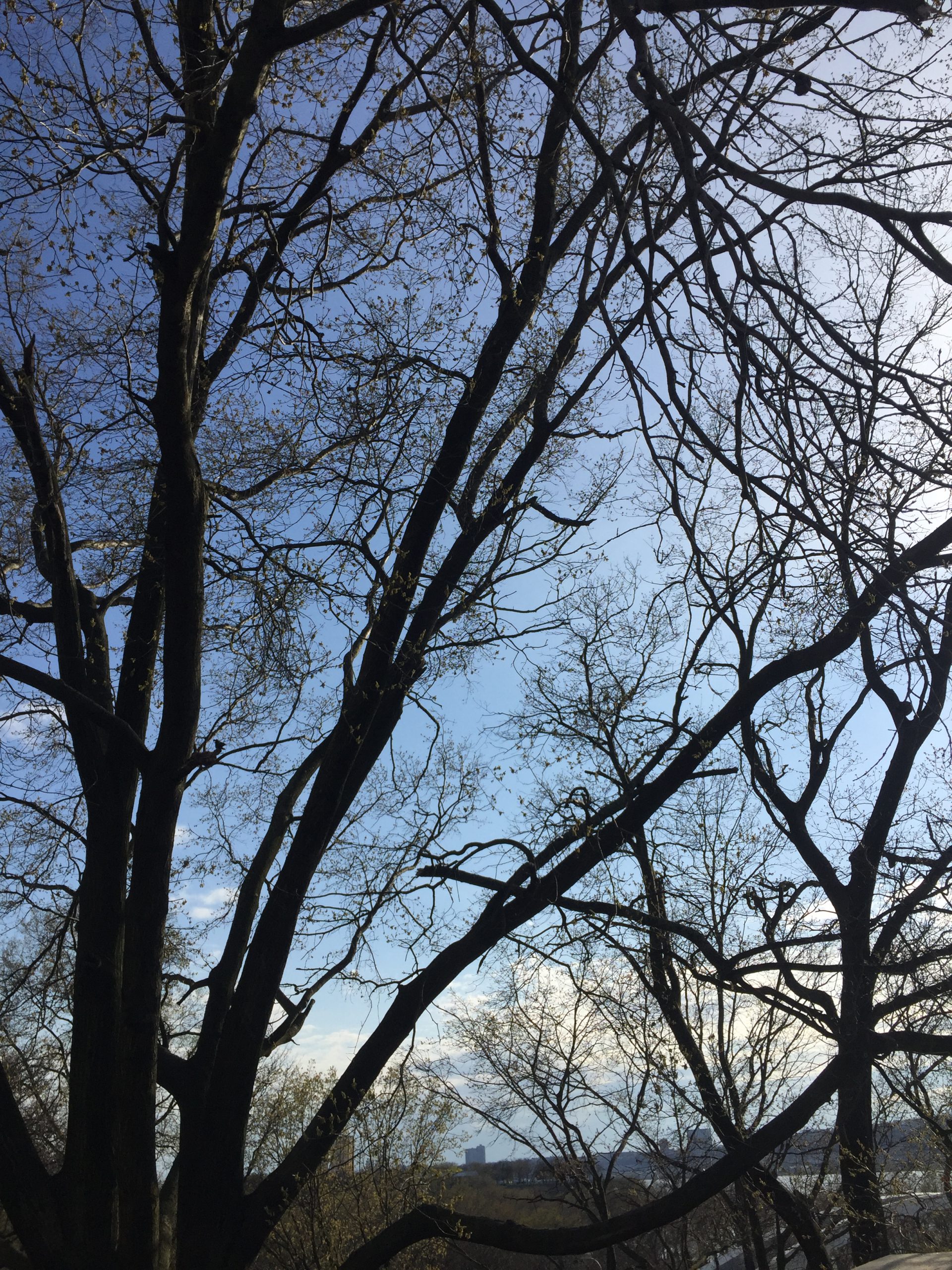
Sea Level Inferno
Long before 9/11, long before now, I prophesied that religious figures would try to destroy NYC by fire.
This short version of a concert-length version features pre-recorded music by various groups. The original was a silent video projection created for the composer/drummer William Hooker. In 1999, that 50 minute film was seen at the New York Underground Film Festival, the Texaco Jazz Festival, Tonic, The Anthology Film Archives, Real Art Ways, and about a dozen venues in the Pacific North West.
Actors in the film are: Michael Wiener, Carleigh Welsh, Michael Portnoy, and Beau Van Donkelaar.
The High Line, September 2018
I love coming to know a city through walking. When I was last in New York in early Autumn 2018, I travelled by foot almost everywhere – from Mid to Downtown Manhattan, across Brooklyn Bridge to the Time Out Market and from Brooklyn Heights down to Carroll Gardens. Amongst my many photographs mapping these treks, are a series of short audio-visual clips on The High Line. In the late, warm afternoon sun, walkers meander lazily, casting their fleeting shadows on the trees and foliage of the Line. The moving imagery and sounds are now traces of a fully breathing city, in temporary slumber, waiting to dazzle again.
View from a window in Chantal Akerman’s film “Là-Bas”/ “Down There”
In 2005, filmmaker Chantal Akerman spent a month in Tel Aviv where she had planned to make a film on life in Israel/ Palestine during a period of intense violence. Daunted by the killings she knew were occurring almost every day, she decided to shoot from the safety of her apartment, shooting her entire film from inside toward the outside, through a single window. Akerman screened “Là-Bas/ Down There”, her remarkable, austere film on this time in her life, at the 2006 Jerusalem Film Festival where I was presenting my film “States of UnBelonging”. For me, it was a dream come true of a sort, meeting Akerman and having a chance to talk to her about her work. Now 14 years later, I think about our own DAUNTING NOW, the witnessing we do from our Corona-framed solitude through our windows, what we see and what we don’t. Unless we are sick ourselves or are first responders, we too, like Akerman, sink into the horrors of our own imagination. Across the years and across our community of filmmakers, there is a RETE, a network, that connects me to her, and all of us to the impulse she had to observe from her hermetically sealed environment, always fearing the puncture.
You can see the entire film here: https://ovid.tv/details/_1864469369001
VATICINATION? What did the kid know?
Julie Peppito, a Brooklyn artist whose work is very much driven by her concern for the environment, lead a collage workshop to toddlers and pre-teens, making a collage with broken toys, images and various craft materials. It was President’s Day, 2020. Fantastic works were created by dozens of kids. I photographed several of them. One gave me pause, the one with the gas mask. I thought “Oops, did we supply that image in the trove of materials we presented?” I moved on and forgot about it.
With the Coronavirus lockdown I prepped my studio for working from home, clearing off my table, sorting files, setting up office. Organizing my computer’s desktop was next. I created a folder for this and a sub-folder for that, I deleted ancient files to free up gigabytes of space, and I hooked up the external drive I brought home. As I brought order to current projects, I categorized recent photographs, like those I took of that workshop and the works her pupils composed. The gas mask! There it was again, yes, I recalled my pause. However, not until now did I spot the doorknob in the piece. Was this kid on to something? What did he know? The coronavirus had crossed our borders under the radar of presidential denials. Had the kid read between the lines? Did he attend the workshop with Purell in his pocket? How would he have answered, if he’d been asked “What would you want to share with the world?”
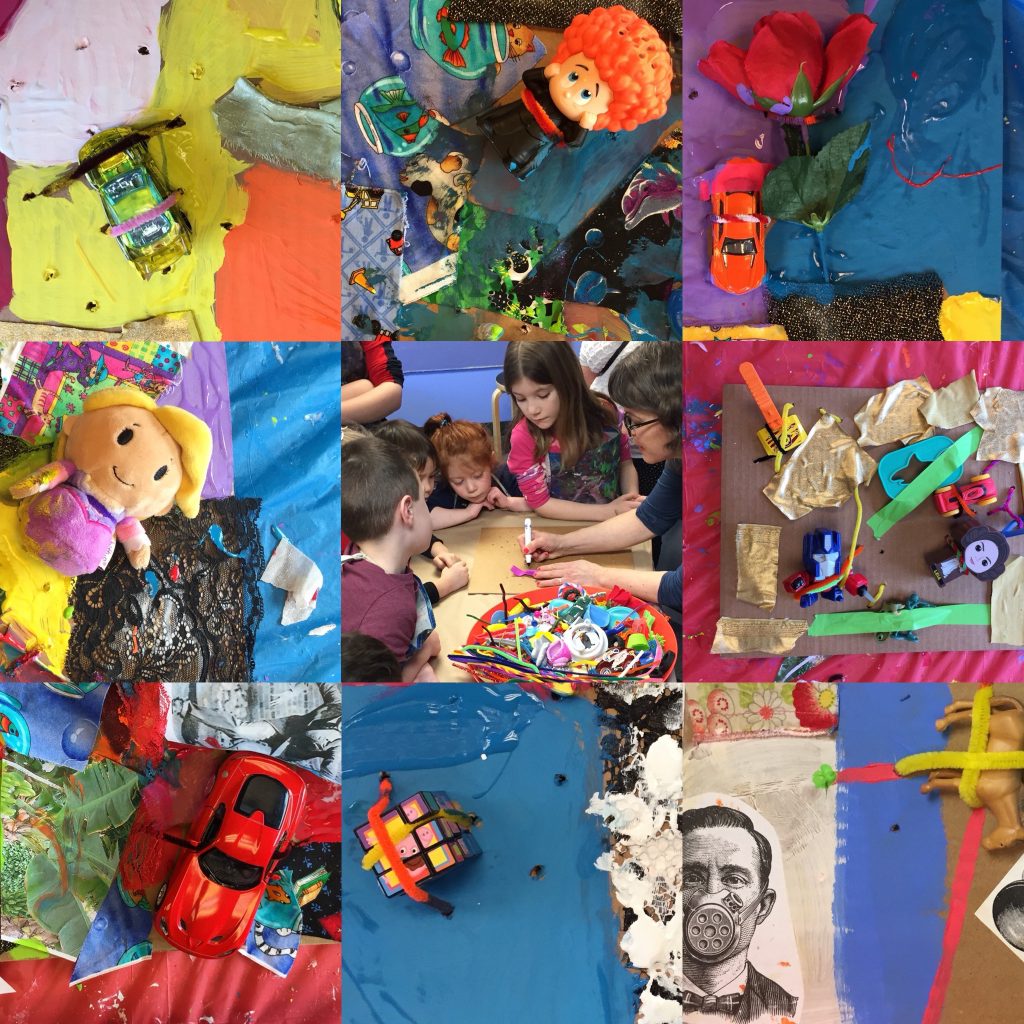
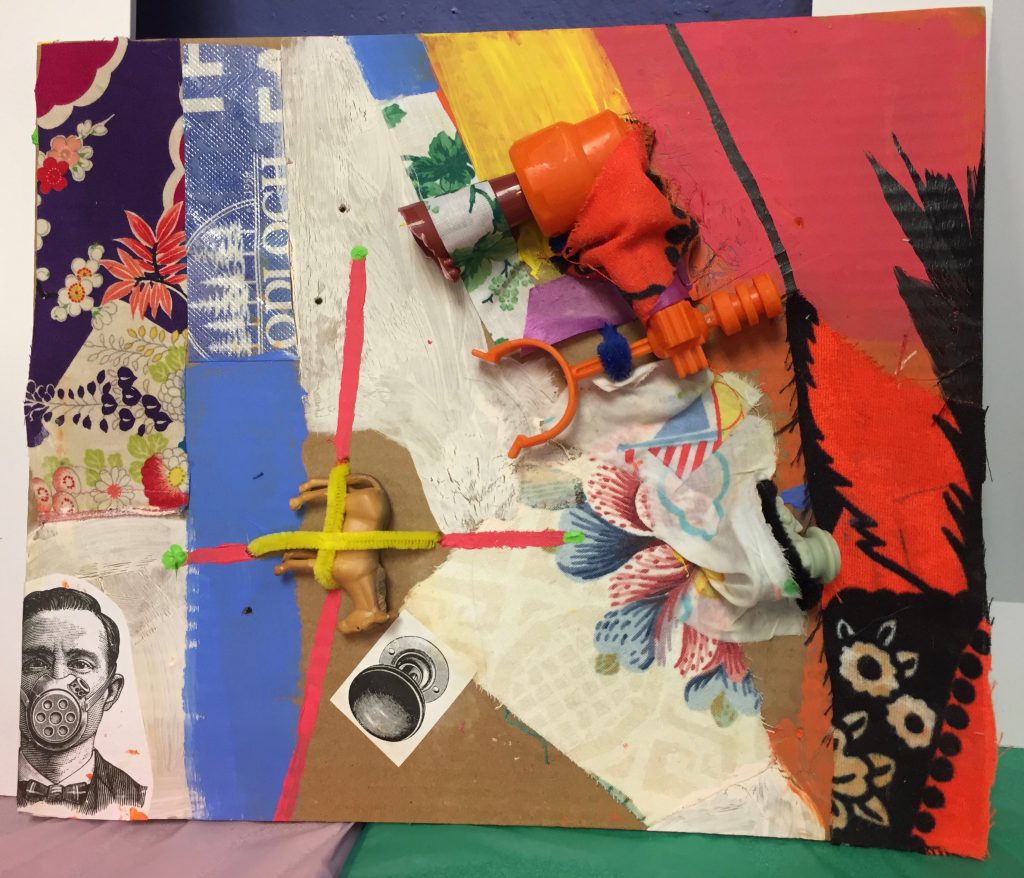
The Artifact
A kitchen rag, a deep dive, a lexicon expanded.
The first time I hovered over a manta ray on the bay of Fernando de Noronha Island, was one of those moments that you want to prolong indefinitely. The graciousness of that aerodynamic span, the perfect water temperature as I coasted the stream, the shimmery surface of this polka-dotted mild beast, everything conjured up the necessary requirements for enchantment.
I can’t say as much about the old kitchen rag, previously a gift from my son’s Swedish godmother, which I was scalding with vinegar, detergent and boiling water. It caused a whole other configuration of astonishment and the combined smells made me slightly dizzy. Perhaps my head had already been set spinning the moment I caught myself scavenging the house for needle, thread and cloth. I had never spent so much uninterrupted time inside this house. I found my snorkeling mask in the closet. A mere two weeks ago I had seen pictures of an Italian man sporting one of those at the supermarket and I laughed at his ingenuity.
My unmeasured love of diving is tied to how it brings me an alternate reality so different from my own, without gravity, where the refraction of light through a liquid medium charms me so that I endow this object, this mask, with an affection by proxy. I washed it with lavender detergent, and I leave it handy now.
Was I exaggerating? But it was the CDC that recommended the use of masks and I found these instructions on the New York Times. I’m really bad at following even recipes willy nilly, but I did just so for this mask. It was sunny out, so I sat on the balcony to catch some fresh air and put on a mild playlist. Normally, these little projects confer a particular sense of competence, when I dominate a new skill. I recognized this sentiment in the glimmer in my son’s eyes when I taught him how to cook risotto. Having barely turned 14 in reclusion, he’s been recruited into a range of chores. I taught him how to operate the washing machine, the vacuum cleaner, how to fold sheets, and brush the toilet bowl. I sent Maria, our cleaning lady, money to stay home and started a spreadsheet for what has now become our cleaning routine.
Manual labor has been the easy part. To read something like cultural criticism by Lauren Berlant, that is hard work, and although I don’t necessarily miss these deep dives, when I do manage them, it brings me great relief, as it feels like recovering a choreography one thought forgotten.
I choose a light gray thread that will look discreet against the blue striped fabric and used my son’s school ruler to measure the fabric and get distracted thinking of the paradox at hand; everyone covering themselves up in masks, while the most raw and explicit in us was becoming increasingly visible—fear. One or two uncertainties lend charm to life and mobilize our poetic sensibility. Yet a snowball of the same prime-material, striking us down, not only leaves us at a loss but it also crumbles entire façades, and renders transparent forces palpable. My Irish neighbor, who previously would barely muster a “good morning”, now posed incisive questions about my supplies, as I struggled to move my heavy shopping cart. The French photographer with whom I went out a couple of times before he vanished, now reappeared in my texting thread. Failing to see the point of his investiture, I just wished him luck before stanching the correspondence. Who am I to redeem someone at a moment like this?
“I’m pacing my building’s rooftop, why don’t you do the same in your backyard, that way we can pretend to be going for walk?” Natacha suggested by phone. I giggled, waking up my facial muscles to this rarified exercise in the last few weeks, and took her suggestion. She is French-Congolese, I’m from Rio. Among the many subjects broached, we scratched our heads over the impossibility of social isolation in Kinshasa or Rio, where populational density is upwards of five thousand per square kilometer. The denser parts of Lombardy barely reach four hundred. The minute I disconnected the phone I started thinking how global mobility will be affected by this, as airlines go broke, recession tightens, and national estrangements develop. I had spent the last year applying for doctoral research work in faraway universities, with low residency requirements. I had already dreamed up and budgeted this bouncy existence between Europe, New York and my native Brazil. Today, I consider myself lucky to have a backyard where I can hop around and exercise. On the days when I manage to convince myself that it is imperative to train my aerobic capacity, to keep my lungs in top shape, I have no qualms about cranking up Outkast and gallop in lateral and nostalgic stride. On rainy days, I can guarantee that one can hold hands with Glen Hansard to the punishing cadence of Say It To Me Now.
I had scheduled a skype call with my friend Ellen, from Taiwan, to celebrate a week since she stopped having the fever. We met in 2010, disheveled and sweating it out at a Shaolin class in Chinatown. Now, I put on a flowery dress, the aqua necklace my dad had gifted me last year, and I put on eyeliner, as my sister had taught me to on her last visit here. I don’t want my hands to forget how to do that controlled movement. This was less about covering up my unrest with chromatic camouflage, I just thought Ellen deserved to have someone on the other side of the screen who bothered to get ready for this lunch date, so pomp could fill in where no physical presence was to be found. Our salutation bows replaced by computer mike testing protocols.
There is one step in mask making which consists of turning it inside out, disemboweling so to speak, to reveal the strings attached to the double cloth sandwich. At this point, this could have easily been a comfort toy for my niece, already isolated in Mauá. But I confirm this artifact’s destiny as mask, remembering my last conversation with my friend Basia: “They use it all over Asia, and they managed to reign in the curve. If nothing else, people tend to steer clear from you on the street, this is useful in lowering supermarket contact.” Basia sent her dad back to Poland via Berlin, left her doctor husband in Queens and is living out of her mother’s basement upstate. Juan, her husband, is from the Basque country in Spain. A trained surgeon, he now swabs patients suspected of being positive for the virus. Today, she has already posted about his using a plastic liner in lieu of protective gear. The peak for hospital demand is not supposed to hit until late April. How first-world-ism is going to be redefined after this, or how many façades will come down until I retire my hand sown mask is a source of endless contemplation, which I hope will bubble up at every dinner table, every prolonged shower.
“Yes, darling you can have a sip of my wine, but only after two forkfuls of rice. “ Fourteen years of age, third week homebound, I let it slide. Has my parental mask of exemplary role model fallen? Not a minute too soon. He asks me about the meaning of the word genocide, which he overheard me saying while talking to a friend from São Paulo. I offer him the leftovers of our homemade birthday cake. His lexicon, my split ends, we will all come out of this overgrown.
The first use of my cloth mask takes place when I go to the ATM to get cash. I needed to pay Freddy, the Colombian handyman who came over to fix a small leak. He has no paypal or bank account, because he is part of the transparent thread stitching this town at the seams with undocumented labor, under accounted, under addressed. The longing to be underwater is suddenly no longer something I can simply indulge in. Once I used the bank’s keypad, believed to be a viral hotbed, I started treating my own hand as a radioactive object. I brought it home, and straight into the sink, without sparing my jacket’s sleeves, then undressing entirely, adding to the laundry pile. Except for the mask itself, that I washed by hand, with boiling water again, so that it would be ready for use the next day, or until the ones I ordered online got here. Between the risk of postal service closures and valid Amazon strikes, I come to terms with the fact that I am already living in a reality very different from “my own”, with gravity, where any refraction of light charms me, because neither my sight, olfactory or tasting capacities have suffered losses, so I endow this object, this mask, with an affection for caution as we face this invisible beast.
Living in an Open City during Covid 19
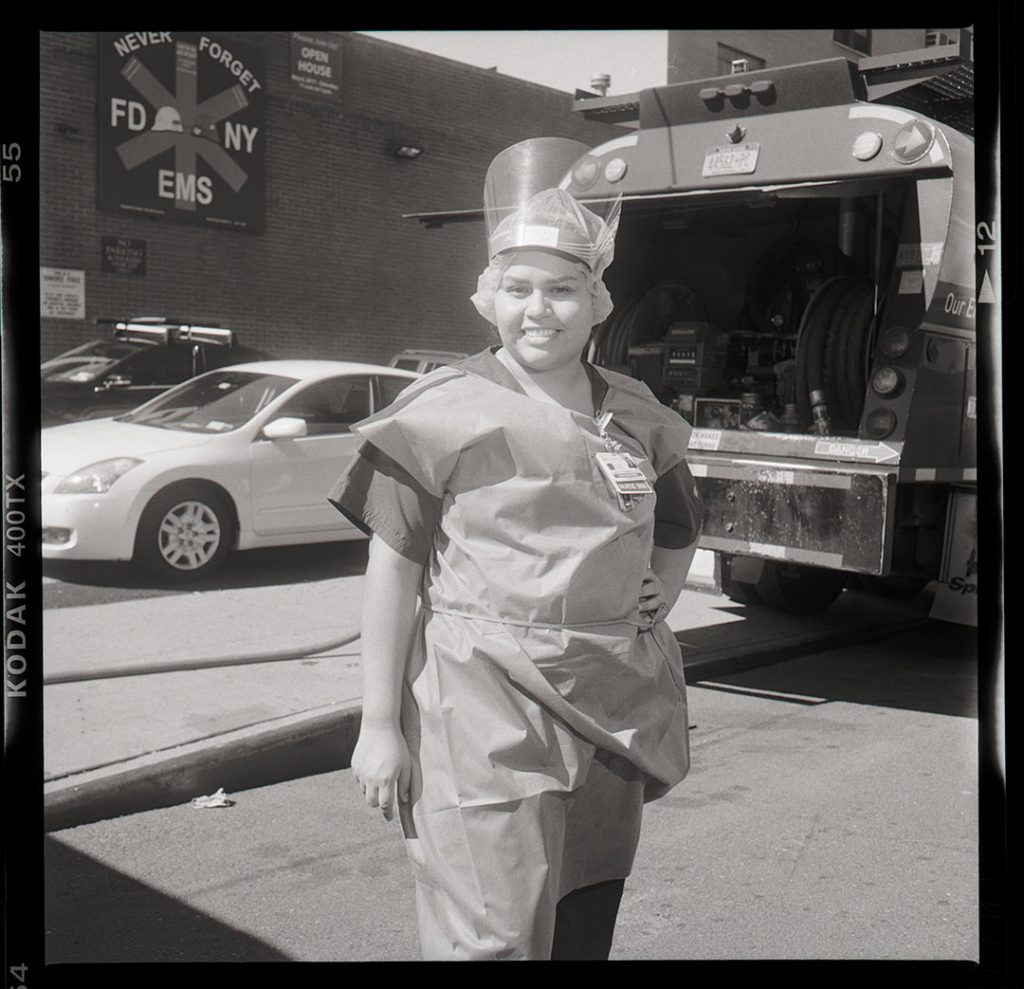
The Covid Journal
The Covid Journal is a project I launched a few days ago. It’s my response, my contribution, my attempt to be useful in this incredibly strange and difficult moment. On a regular basis I am going out into my community which includes one of the most virus besieged hospitals in this virus besieged city, Elmhurst Hospital.
Coronavirus: a QUIDNUNC’s misery (and wonder)
A door viewer, or the QUIDNUNC’s peephole is no longer of use these days. Nary a soul in the streets! One might as well slouch behind one’s PC and crash a Zoom party. That is, until wild life starts filling the streets. Anyone, even the quidnunc, would be at a loss for words.
